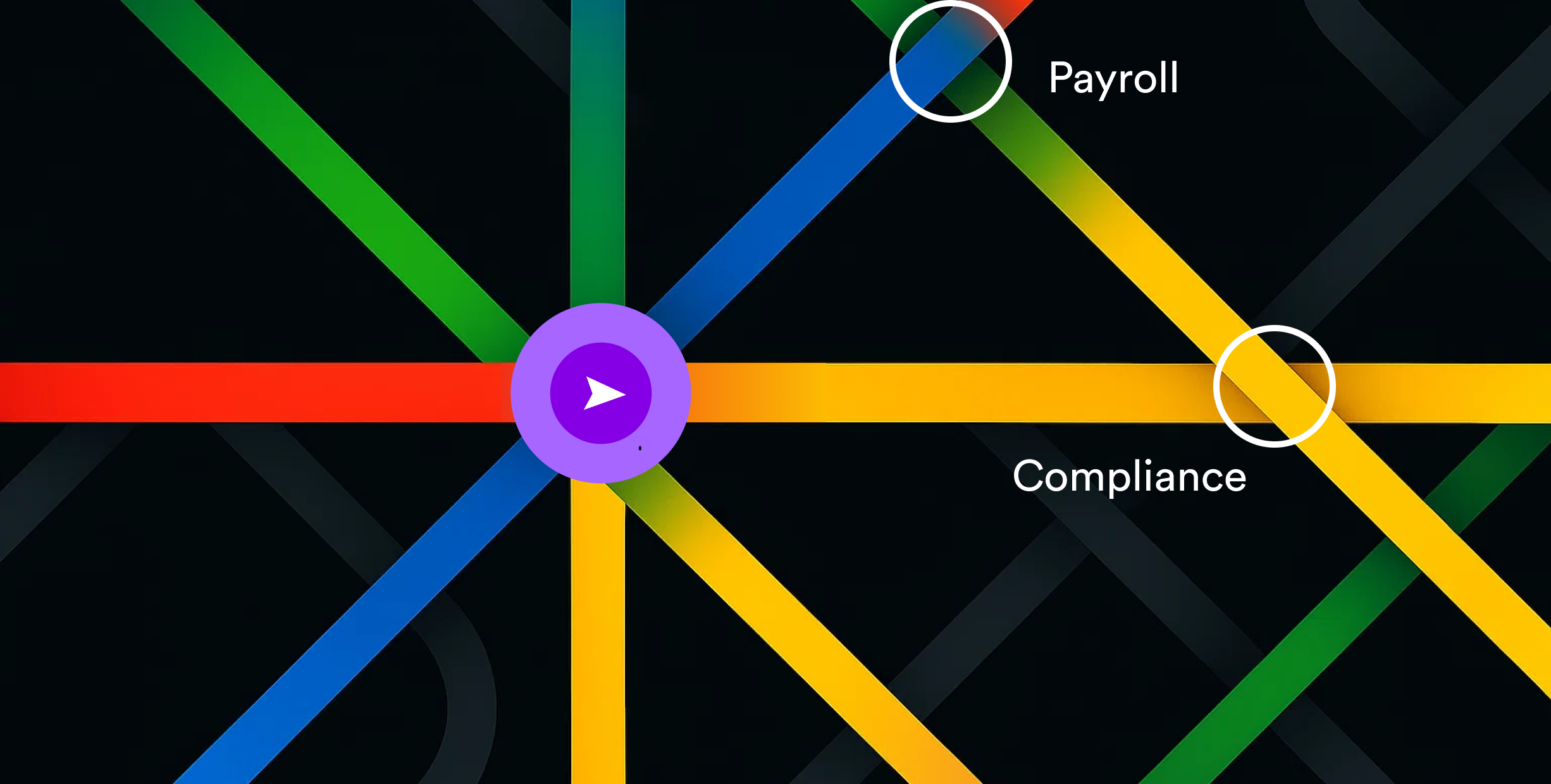What a Self-driving Payroll System Actually Looks Like (and Why It Matters for Global Teams)
How automation and AI are transforming payroll into a strategic advantage for global companies.

Introduction: The evolution of payroll in a globalized world
Payroll has long been seen as a necessary but manual back-office task. That’s changing fast. As automation and AI reshape how businesses operate, payroll is evolving from an administrative burden into a strategic growth enabler.By 2025, 80% of companies are expected to use automated payroll systems, marking a major shift toward smarter, faster, and more accurate operations. For global teams, that transformation is especially important — cross-border compliance, tax obligations, and multi-currency payments make manual payroll nearly impossible to manage at scale.The question is: what does a truly self-driving payroll system look like? And how does it change the way global companies operate?Each country has its own labor laws, tax codes, and compensation requirements. Managing this complexity across dozens of markets is where AI-boosted automation shines. These systems can interpret local regulations in real time, update calculations automatically, and prevent costly compliance errors.They also unlock workforce intelligence. By analyzing payroll data, companies can identify pay equity gaps, track compensation trends, and forecast costs. This level of visibility helps HR leaders make smarter strategic decisions — and ensures employees receive fair, timely pay across borders.Understanding the self-driving payroll system: beyond automation
A self-driving payroll system automates the full lifecycle — from wage and tax calculations to filings, compliance, and payments — with minimal manual oversight.Unlike traditional payroll software that requires constant configuration, these systems use machine learning to anticipate and handle updates automatically. For global teams, that means less time spent on setup and more time focused on growth.Self-driving systems reduce the risk of human error while ensuring employees everywhere are paid correctly and on time. For startups and scaling companies, they eliminate the need to master tax codes or employment laws for each market, freeing founders and HR teams to focus on what matters most: growth and innovation.Key features of a self-driving payroll system
- Automated compliance: Tracks tax filings, benefits, and employment laws across multiple countries automatically.
- Real-time payroll processing: Cuts processing times — global averages have dropped from 15 days to around 10 — improving cash flow and employee satisfaction.
- AI-powered insights: Detects anomalies, forecasts payroll trends, and optimizes cost allocation.
- Seamless integrations: Syncs payroll with HRIS, finance, and accounting platforms for unified data visibility.
- Employee and contractor self-service: Allows employees and contractors to manage their bank details and access pay slips, tax forms, and support directly.
Why self-driving payroll systems are a game-changer for global teams
Running payroll across multiple countries is complex and error-prone. Different jurisdictions mean different tax rates, deductions, and payment standards. Without automation, keeping up with these moving parts is a full-time job.Self-driving systems solve that problem by combining global automation with local compliance. According to the 2025 ISG Provider Lens® Global Payroll Managed Services Report, companies are increasingly investing in AI-driven payroll technology to manage cross-border operations efficiently.For HR leaders overseeing teams of 50 to 200 people, these platforms reduce manual workload and improve transparency. Over 60% of HR leaders say payroll automation improves both accuracy and compliance — vital for multinational operations where errors can lead to penalties.Companies using AI-enabled payroll automation also report average cost savings of more than 15%, demonstrating that automation isn’t just more efficient — it’s financially smarter too.Supporting compliance without the headache
Compliance remains the single largest source of payroll-related stress. Managing filings across multiple tax systems, benefits programs, and payment rails is time-intensive and risky.Self-driving payroll systems handle this automatically. They monitor and update for every new regulation, calculate taxes correctly for each country, and file reports on time — all within one platform.For a Head of People managing dozens of jurisdictions, this centralization removes hours of manual work and mitigates risk. Integrated analytics provide further value, helping HR and finance leaders identify opportunities to optimize pay structures and forecast costs with precision.When connected with HR tools — such as performance or engagement systems — self-driving payroll becomes part of a seamless ecosystem that gives leaders a single, real-time view of their workforce worldwide.The human impact: why payroll automation matters beyond numbers
Payroll may be data-driven, but its impact is deeply human. It touches every employee’s financial well-being, trust, and engagement. A reliable, transparent payroll experience builds confidence and retention.For founders, it means peace of mind — knowing payroll is handled accurately without hours lost to compliance paperwork. For HR teams, it means fewer support tickets and a smoother employee experience.By offering employee and contractor self-service portals and real-time assistance, these systems empower workers to edit their bank details and access their own pay slips and tax documents whenever they need — no waiting, no back-and-forth emails. That autonomy fosters trust and helps employees feel supported and secure.Balancing automation with augmentation
While automation replaces repetitive tasks, augmentation AI enhances human capability. Applied to payroll, that means AI doesn’t replace HR professionals — it elevates them. By taking over repetitive calculations and filings, it gives HR teams the space to focus on strategic work like retention, culture, and workforce planning.Choosing the right self-driving payroll system for your company
Not all payroll systems are built equally. The right solution depends on your company’s size, maturity, and goals.Early-stage startups need simplicity: transparent pricing, fast onboarding, and intuitive automation that doesn’t require complex setup or deep expertise. Founders want payroll that just works, not another tool to manage.Growth-stage companies need scalability. They require standardized global hiring, compliance documentation, and responsive support. The ability to adapt to new countries quickly and manage complex payroll data securely becomes a core business need.Where to find and evaluate payroll solutions
Both founders and HR leaders rely heavily on peer recommendations when choosing payroll platforms. Founders and HR leaders often discover solutions through professional communities, LinkedIn groups, industry events like SHRM and UNLEASH America, or through referrals from other operators.Before buying, they review demos, ROI summaries, and compliance snapshots to validate fit. Transparency on pricing, SLA commitments, and customer support responsiveness is non-negotiable.Looking for case studies from similar companies is also key. Real-world examples demonstrate how a solution performs under global scale — and whether it improves accuracy, cost, and employee satisfaction.Conclusion: the future is self-driving and global-ready
As businesses expand across borders, self-driving payroll is fast becoming a necessity. These systems transform payroll from a reactive process into a proactive, intelligent function that drives efficiency, compliance, and employee trust.With 80% of companies adopting automation by 2025 and AI powering double-digit cost savings, the future of payroll is not just automated — it’s self-driving.By choosing the right system, founders and HR leaders can eliminate administrative headaches, minimize compliance risk, and guarantee their teams are paid accurately and on time — wherever they are in the world.Ready to elevate your global payroll experience?
Embrace the future with Plane. Plane simplifies hiring, onboarding, and paying your global workforce through one unified, compliant platform. Automate payroll, streamline HR, and scale internationally — all while staying compliant in every market.Focus on growth. Plane handles the rest. Get started today and experience the future of global payroll management.Related articles
From startups to beyond, US companies of all sizes use Plane for global payroll, benefits and compliance.
Why Most Payroll Systems Fail International Teams
Traditional payroll tools weren’t built for how modern companies hire and grow across borders.
The Ultimate Guide to International Leave Laws
How to manage vacation, sick leave, and parental benefits across borders without breaking compliance.
How Plane Helps You Stay Compliant in 240+ Countries
A closer look at the laws, systems, and real-world workflows that make global hiring simpler — and safer.
